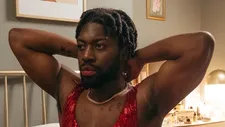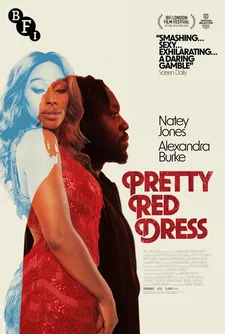 |
| Alexandra Burke and Natey Jones in Pretty Red Dress |
Dionne Edwards’ directorial feature debut, Pretty Red Dress, tells the story of Travis (Natey Jones), who returns to his wife Candice (Alexandra Burke) and daughter Kenisha (Temilola Olatunbosun), having served time. When Candice, who has an audition to play Tina Turner in a new musical, eyes a red dress in a shop window, Travis buys it for her. Something strange happens – Travis finds himself drawn to the dress. He begins wearing it secretly, but why? To feel pretty, he tells his daughter when she discovers him crossdressing. Travis’ exploration of his feminine side changes the family’s dynamic in unexpected ways, and challenges his masculine identity in their urban South London community.
In conversation with Eye For Film, Edwards and Jones discussed the deeper meanings of their crossdressing story, how it was driven by a search for answers, and their interest in thought and feeling instead of a big statement.
Paul Risker: Pretty Red Dress is interested in human nature, and despite its central crossdressing premise, explores universal themes that will resonate with audiences.
 |
| Alexandra Burke in Pretty Red Dress |
Natey Jones: It's interesting that you mention the universality of the film, because I hope it will continue to live on as a metaphor for freedom and self-acceptance. Whatever Travis goes through individually as a character, you can extrapolate that into anything we struggle with ourselves, whether it be something like crossdressing or sexuality, goals and the dreams you may have.
Some will be restricted by societal and family opinions, but this film expresses honouring yourself - what you want to be and achieve in life, that leads to some sort of freedom.
Dionne Edwards: Tying into its universality, you could set the same story inside a Polish family, a Russian family or a Middle Eastern family. Obviously it would be a little bit different culturally, but a lot of the reactions you'd get from the characters would be similar. Hopefully, this goes alongside the discussion of masculinity and femininity, and how that applies to different cultures.
PR: Recalling the idea that there are so many archetypal stories, is one of the reasons because films, like dreams, serve to help us to understand our world? Hence, are the same stories told again and again in order to help each generation deal with those cyclic themes that confront it? Should we not necessarily put originality on a pedestal, but embrace the parallels between stories, and search for what’s different in the familiar?
NJ: I try not to get distracted by too many opinions of things and instead embrace the material you have to work with. What's important in this film is the representation of this black family. Maybe we've seen this story before, maybe we've seen it in different demographics, but in this film specifically, it's beautiful that we get to see the experiences of this urban South London family. Maybe that brings out something different, or maybe it just humanises a group of people differently than many other films might have before now.
DE: Creativity in general is taking different forms and putting them together again. Humans mostly have the same stories, and so it's about how you take different pieces and thread them together, to see what comes out. I think that's the magic of it.
 |
| Natey Jones in Pretty Red Dress Photo: Courtesy of London Film Festival |
PR: When I was interviewing filmmaker Sean Brosnan for My Father Die, he explained: “I know a lot of friends who pick their themes first or they’ll pick a story and then say: ‘What do I want to explore?’ I find for me that is very limiting because I just like to explore a world and its characters; to see what theme comes out of that and to let the story dictate it.” Each storyteller takes a different approach. But to speak about theme, are you attentive to specific themes from the outset or is it a journey of discovery?
DE: It was around 2014 and I was trying to think up a bunch of different ideas for a feature. I was working on a film that came to be the short, We Love Moses. Some of the themes I was interested in exploring were family and self-love, sexuality, secrets and alienation, and the things that we do to hide or mask ourselves.
It [Pretty Red Dress] followed on from my short film in a way. I got the Travis character first, explored him a little bit, but it all started with the characters. I was listening to a lot of Tina Turner and I always said I don't know how the red dress came into it, whether it was Tina Turner, or the red dress. But that came out of Candice's story and it all blended. It relates to what we were just saying about taking lots of different pieces and putting them together.
PR: Travis is an authentically rich character who never feels contrived. What was your process for developing this emotionally complicated character?
NJ: Once you're placed with the character, the immediate thought is, ‘How the hell am I going to do this?’ [Laughs.] This person who is either really similar to me in one way, or extremely different in another. You have to start from scratch and figure out how you're going to play this character authentically, and Travis has so many facets to him. Physically he's an imposing figure. He has come from an inner city lifestyle and he has been to prison. But most interesting about him is the softness deep in his core, which is used as a motivation for a lot of his anger and toxicity.
He's deeply vulnerable, and as a viewer you can at the very least understand his actions by understanding there's something troubling him at his core. To get to that point, Dionne helped by giving me a lot of information about crossdressing for example - documentaries and articles.
 |
| Alexandra Burke in Pretty Red Dress |
At the start of trying to investigate this character, there were two extremes: the masculine and the feminine. It was helpful to look at the two extremes and to just delve into crossdressing - who decides to do it, why do they decide to do it, and to see what could be Travis’ reason.
[…] On one of the documentaries, one man spoke about his love of femininity, the female form and the love of a woman. Travis happened to have so many strong female characters around him and that was a nice opportunity for me to connect to those individual relationships. The female relationships really show how much Travis is devoted to them.
It’s a slow process building a character and you feel like you're never going to get there. Then it slowly starts to speed up, and as you get closer to filming, you're rapidly figuring out these things - how he walks, how he talks, and the blend between the masculine and the feminine slowly comes together. The rehearsals helped to press the nitro button and create this character. Working with Alexandra and Temilola, we created a family, and so by the time we started filming, we were connected, but also versatile and able to change things.
PR: The societal conversations about sexuality and gender are opening up deeper ideas about the way we think about ourselves and others, albeit there’s an inevitable resistance. Pretty Red Dress is a timely film, encouraging a conversation by using cinema as an empathy machine, opposite the mainstream news media that talk at their audience. The value of cinema is it can disarm audiences and open their minds in a way that other media struggles to do.
NJ: The film is a conversation, and what Dionne's done beautifully is to not necessarily create a protagonist. No one's in the wrong, but people are experiencing things individually and collectively. They're all flawed - this is a beautifully dysfunctional family that we experience, and they constantly make mistakes. I think you're on their side and you understand why they're all struggling.
What we don't necessarily have in news media, or, social media for example, is the conversation. We've got limited characters [on Twitter], or a picture where you can place words on it, but the conversation is missing. So it's a very binary conversation to use that term, where you're on one side or the other. With this film you have a conversation and show the humanity. Rather than the destination of who this person is this, it’s about the journey to joy or acceptance, and why they're struggling with that. This is what’s beautiful about the film.
 |
| Pretty Red Dress poster |
DE: I wasn't necessarily trying to make a social or political point, or trying to steer an agenda with the film. We’re all made up of the feminine – some men are extremely masculine, and some women are extremely feminine. Some people are in the middle, but we don't always get to express that, and if we do, then there can sometimes be strange consequences.
I was more interested in thinking about it and the feeling of it, more so than trying to make a big statement. If it does make a statement and people relate to it, that's fair enough, but it definitely wasn't the agenda.
PR: You can never control the way the audience will respond. Your film challenges the way we've been trained to pigeon hole and simplify what films are and what they mean. Pretty Red Dress is about so much more than crossdressing, it’s only one part of an exploration of human nature. It’s important to find a deeper appreciation in life, whether it be for art or other people. This process of simplification can be harmful, diminishing and dehumanising.
DE: While I was developing the script, the execs wanted harder answers to things. They'd say, "Well, why is he doing that?” There's a great moment, which is one of my favourite scenes in the film, where Travis is talking to his daughter Kenisha. She asks why, and he says, “I just want to be pretty sometimes.” That’s not necessarily a satisfying answer, but the answer seems to fit the moment. One of the points of the film is that there are no neat answers in life. We are some things and we are many things, and as you say, we can't put things in boxes all the time.
NJ: The beauty of being a part of this film was that there wasn't an answer, and the journey for me as an actor playing this character was how Travis is figuring it out as he goes along. Sometimes he's doing better, other times he's not doing so well, but the journey is trying to figure it out.
DE: As an actor you usually have to come up with the reason for things. Was that hard then, and how did you approach that?
NJ: It was the inner conflict. Travis is from this [urban] environment and he has many iterations - when he's alone, when he's with his partner, and when he's with his daughter. How free is he in any one of those situations? He's alone when he's outside, and so it was the struggle of how free can he be? Can he say anything? Can he be honest? It was a constant struggle and frustration within him that was painful at times, because he was like a bomb made to explode. To answer the question, he didn't know, and I didn't know. The beauty of the film was figuring it out while we were doing it.
























